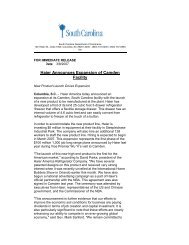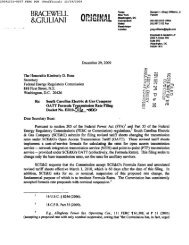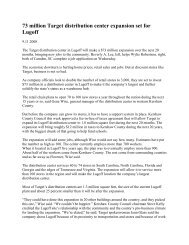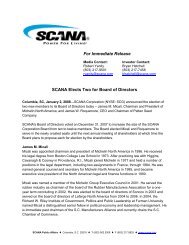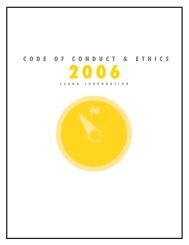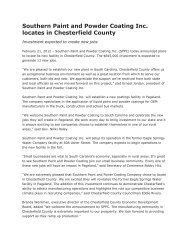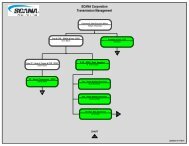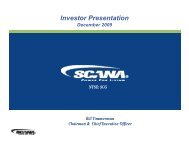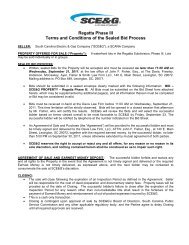10-K - SCANA Corporation
10-K - SCANA Corporation
10-K - SCANA Corporation
Create successful ePaper yourself
Turn your PDF publications into a flip-book with our unique Google optimized e-Paper software.
Table of Contents<br />
To help mitigate the financial risks arising from these potential occurrences, SCE&G maintains insurance on certain properties and<br />
has collected funds from customers for its storm damage reserve (see Note 2 to the consolidated financial statements). As part of its<br />
ongoing operations, SCE&G maintains emergency response and storm preparation plans and teams, and applicable personnel<br />
participate in ongoing training and related simulations in advance of such storms, all in order to allow Consolidated SCE&G to protect<br />
its assets and to return its systems to normal reliable operation in a timely fashion following any such event.<br />
In December 2009, the EPA issued a final finding that atmospheric concentrations of GHG endanger public health and<br />
welfare within the meaning of Section 202(a) of the CAA. The rule, which became effective in January 20<strong>10</strong>, enables the EPA to<br />
regulate GHG emissions under the CAA. The EPA has committed to issue new rules regulating such emissions in 2012. The Company<br />
expects that any costs incurred to comply with GHG emission requirements will be recoverable through rates.<br />
In 2005, the EPA issued the CAMR which established a mercury emissions cap and trade program for coal-fired power<br />
plants. Numerous parties challenged the rule and, on February 8, 2008, the United States Circuit Court for the District of Columbia<br />
vacated the rule for electric utility steam generating units. In March 2011, the EPA proposed new standards for mercury and other<br />
specified air pollutants. The rule, which becomes effective April 16, 2012, provides up to four years for facilities to meet the<br />
standards. The rule is currently being evaluated by Consolidated SCE&G. Any costs incurred to comply with this rule or other<br />
rules issued by the EPA in the future are expected to be recoverable through rates.<br />
The EPA is conducting an enforcement initiative against the utilities industry related to the NSR provisions and the new<br />
source performance standards of the CAA. As part of the initiative, many utilities have received requests for information under<br />
Section 114 of the CAA. In addition, the DOJ, on behalf of EPA, has taken civil enforcement action against several utilities. The<br />
primary basis for these actions is the assertion by EPA that maintenance activities undertaken by the utilities at their coal-fired power<br />
plants constituted “major modifications” which required the installation of costly BACT. Some of the utilities subject to the actions<br />
have reached settlement.<br />
To date, SCE&G and GENCO have received and responded to Section 114 requests for information related to Canadys,<br />
Wateree and Williams Stations. The current state of continued DOJ civil enforcement is the subject of industry-wide speculation, and<br />
it cannot be determined whether Consolidated SCE&G will be affected by the initiative in the future. Consolidated SCE&G believes<br />
that any enforcement action relative to its compliance with the CAA would be without merit. Consolidated SCE&G further believes<br />
that installation of equipment responsive to CAIR previously discussed will mitigate many of the alleged concerns with NSR.<br />
Water Quality<br />
The CWA provides for the imposition of effluent limitations that require treatment for wastewater discharges. Under the<br />
CWA, compliance with applicable limitations is achieved under a national permit program. Discharge permits have been issued and<br />
renewed for all of SCE&G’s and GENCO’s generating units. Concurrent with renewal of these permits, the permitting agency has<br />
implemented a more rigorous program of monitoring and controlling discharges, has modified the requirements for new cooling water<br />
intake structures, and has required strategies for toxicity reduction in wastewater streams. The EPA has said that it will issue a rule by<br />
mid 2012 that modifies requirements for existing cooling water intake structures. Consolidated SCE&G is conducting studies and is<br />
developing or implementing compliance plans for these initiatives. Congress is expected to consider further amendments to the CWA.<br />
Such legislation may include limitations to mixing zones and toxicity-based standards. These provisions, if passed, could have a<br />
material impact on the financial condition, results of operations and cash flows of the Consolidated SCE&G. Consolidated SCE&G<br />
believes that any additional costs imposed by such regulations would be recoverable through rates.<br />
Hazardous and Solid Wastes<br />
The EPA stated its intention to propose in late 2012 new federal regulations affecting the management and disposal of CCRs,<br />
such as ash. Such regulations could result in the treatment of some CCRs as hazardous waste and could impose significant costs to<br />
utilities, such as SCE&G and GENCO. While Consolidated SCE&G cannot predict how extensive the regulations will be,<br />
Consolidated SCE&G believes that any additional costs imposed by such regulations would be recoverable through rates.<br />
The Nuclear Waste Act required that the United States government accept and permanently dispose of high-level radioactive<br />
waste and spent nuclear fuel by January 31, 1998. The Nuclear Waste Act also imposed on utilities the primary responsibility for<br />
storage of their spent nuclear fuel until the repository is available. SCE&G entered into a Standard Contract<br />
<strong>10</strong>1



